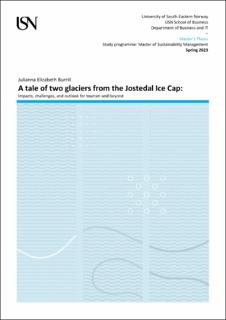| dc.description.abstract | Norway is famous for its glaciers which are often utilized for recreational and tourist activities. The companies that run tourist activities on glaciers, therefore, must deal with the consequences of glacial retreat from climate change. Companies may have to contend with changing tourism patterns such as new hazards, increased risk during activities, fewer tourists, and decreasing revenue. This master’s thesis considers the societal impacts of glacial retreat by comparing two glacial arms situated on each side of the Jostedal Ice Cap. The two glacial outlets, Briksdalsbreen and Nigardsbreen, have considerable importance in local tourism systems. Briksdalsbreen was popular for glacier hiking and tourist activities until glacial decline drastically changed conditions. Briksdalsbreen became unsuitable for guiding due to unsafe access and a dangerously steep frontal slope. However, the changes that occurred in Briksdalsbreen in tourism systems have not yet been quantified and explored. Changes are occurring in Nigardsbreen, with the continued retreat of the glacier for the last decades. A comparative case study approach is used to better understand tourist activities in Briksdalsbreen compared with Nigardsbreen. Qualitative interviews have been conducted with existing guiding companies and those who have gone out of business, to analyze past experiences and understand potential future challenges in adaptation. Quantitative data is presented to understand patterns of visitation, revenue, and tourist demand. Main findings show that steepness was a tipping point in which coping capacities were surpassed. Adaptive thresholds and capacities considered different aspects of adaptation. Social capital factors may intensify experiences of glacial change but may expand potential of adaptive capacity within community members. Glacial tourism systems are on a resilient path but may need to transition or transform in the future as glaciers continue to change and recede. | |
